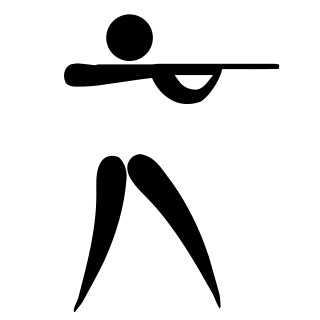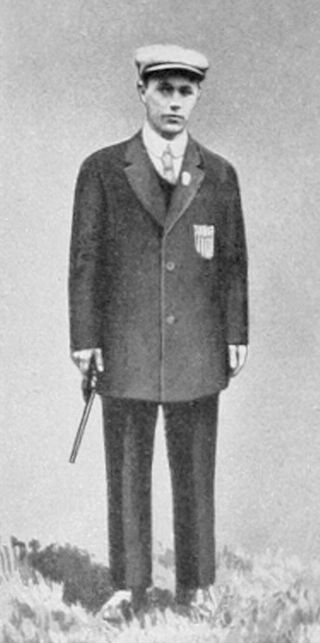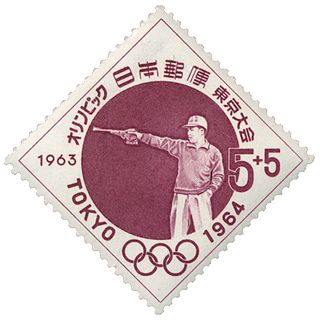
The men's individual competition with free revolver event was one of the competitions in the Shooting at the 1900 Summer Olympics events in Paris. It was held on 1 August 1900. 20 shooters from 4 nations competed, with five shooters per nation. Medals were given for individual high scores, and the scores of the five shooters were summed to give a team score for the team event. The target designed for this competition is still being used today. The event was won by Karl Röderer of Switzerland, with his countryman Konrad Stäheli taking bronze. Between them was Achille Paroche of France with silver.

The men's individual revolver and pistol competition was one of 15 shooting sports events on the shooting at the 1908 Summer Olympics programme. The competition was held on Friday, 10 July 1908. Each nation could enter up to 12 shooters. Forty-three sport shooters from seven nations competed. Nations were limited to 12 shooters each. The event was won by Paul Van Asbroeck of Belgium, with his countryman Réginald Storms taking silver. They were the first medals for Belgian shooters in the free pistol. American James Gorman finished with the bronze medal after an unsuccessful protest, claiming he had put one bullet through a previous hole.

The men's 50 metre team pistol was a shooting sports event held as part of the shooting at the 1912 Summer Olympics programme. It was the third appearance of the event, which had also been held in 1900 and 1908. The competition was held on Tuesday, 2 July 1912. Twenty sport shooters from five nations competed. The event was won by the United States, successfully defending its Olympic title. The American team included John Dietz, a veteran of the 1908 Games, making him the first to win multiple medals in the event. Silver went to Sweden. Great Britain repeated as bronze medalists.

The men's 300 m rifle three positions was a shooting sports event held as part of the shooting at the 1912 Summer Olympics programme. It was the third appearance of the event, which had been introduced in 1900. The competition was held on Tuesday, 2 July 1912. Eighty-four sport shooters from nine nations competed. The event was won by Paul Colas of France, the nation's first medal in the event. Denmark took the silver and bronze medals, as Lars Jørgen Madsen finished second and Niels Larsen placed third.

The men's 30 metre dueling pistol was a shooting sports pistol event held as part of the 1912 Summer Olympics shooting programme. It was later standardized by the ISSF to the men's 25 metre rapid fire pistol. It was the third appearance of the event, as it had not been featured at the 1908 Games. The competition was held on Saturday, 29 June 1912. Forty-two sport shooters from ten nations competed. Nations were limited to 12 shooters each. The event was won by Alfred Lane of the United States, in the nation's debut. Sweden, also making its debut, earned the silver and bronze medals.

The men's 50 metre pistol was a shooting sports event held as part of the Shooting at the 1936 Summer Olympics programme. It was the sixth appearance of the event. The competition was held on 6 and 7 August 1936 at the shooting ranges at Wannsee. 43 shooters from 19 nations competed. Nations were limited to three shooters each, as they had been for all individual shooting events since the 1932 Games. The event was won by Torsten Ullman of Sweden, the nation's first free pistol medal. Erich Krempel of Germany took silver. Charles des Jammonières's bronze was France's first medal in the free pistol since 1900.

The men's ISSF 25 meter rapid fire pistol was a shooting sports event held as part of the Shooting at the 1924 Summer Olympics programme. It was the fifth appearance of the event. The competition was held on 28 June 1924 at the shooting ranges at Versailles. 55 shooters from 17 nations competed. Nations were limited to four shooters each. Henry Bailey won the United States' second consecutive championship in the event. Sweden also earned the same medal as in 1912, with Vilhelm Carlberg's silver. Lennart Hannelius took bronze in Finland's debut in the event.

The men's 30 metre rapid fire pistol, labeled the "revolver" in the Official Report and often described as a "military pistol" event was a shooting sports event held as part of the Shooting at the 1920 Summer Olympics programme. The International Shooting Sport Federation identified this event as the fourth appearance of an individual 25 metre rapid fire pistol event; it was the second time the distance was 30 metres. In 1896 the distance was 25 metres; in 1900, 20 metres. The competition was held on 3 August 1920. 11 shooters from 3 nations competed. The event was won by Guilherme Paraense in Brazil's debut in the event; it was Brazil's first Olympic gold in any event. American Raymond Bracken took silver, while Swiss shooter Fritz Zulauf earned his nation's first medal in the event.

The men's individual competition with revolver and pistol was a shooting sports event held as part of the Shooting at the 1920 Summer Olympics programme. It was the fifth appearance of such an event at different distances. The competition was held on 2 August 1920. 31 shooters from 8 nations competed. The event was won by Karl Frederick of the United States, the nation's second consecutive and third overall victory in the event. Defending champion Alfred Lane took bronze, the first man to win multiple medals in the event. Brazil's Afrânio da Costa finished between the two Americans, taking silver.

The men's 50 metre team pistol was a shooting sports event held as part of the Shooting at the 1920 Summer Olympics programme. It was the fourth and last appearance of the event. The competition was held on 2 August 1920. 65 shooters from 13 nations competed. The event was won by the United States, the nation's third consecutive victory in the event. Alfred Lane returned from the 1912 team, making him the second person to earn multiple medals, and multiple gold medals, in the men's team pistol. Sweden also repeated as silver medalists. Bronze went to Brazil, in that nation's debut in the event.

The men's ISSF 50 meter pistol competition at the 2000 Summer Olympics was held on 19 September. There were 36 competitors from 27 nations. Nations had been limited to two shooters each since the 1952 Games. Tanyu Kiryakov won, becoming the first shooter to win Olympic gold medals in both this event and 10 metre air pistol. 2.7 points behind, Igor Basinski won his fourth Olympic medal. Kiryakov's gold was Bulgaria's first free pistol victory, and the first medal of any color in the event for the nation since 1980. Martin Tenk's bronze was the Czech Republic's first medal in the event.

The men's ISSF 50 meter pistol was one of the fifteen shooting events at the 1996 Summer Olympics, held on 23 July at the Wolf Creek Shooting Complex in Atlanta. There were 45 competitors from 28 nations. It was the first time decimals were used in the 50 metre pistol finals. Boris Kokorev set a new Olympic record after scoring 570 points in the qualification round and 96.4 in the final, winning the gold medal, while places 2 through 5 were occupied by Belarusian and Italian shooters. Russia, Belarus, and Italy all received their first medal in the free pistol. Silver medalist Igor Basinski was the ninth man to win multiple medals in the event.

The men's ISSF 50 meter pistol was one of the thirteen shooting events at the 1988 Summer Olympics. It was the second Olympic free pistol competition to feature final shooting, after an abortive attempt in 1960. There were 43 competitors from 31 nations. Nations had been limited to two shooters each since the 1952 Games. The event was won by Sorin Babii of Romania, the nation's first victory in the event and first medal in free pistol since 1972. Ragnar Skanåker of Sweden repeated as silver medalist, the second man to earn three medals in the free pistol; four years later, he would become the first to win four medals. Soviet Igor Basinski took bronze.

The 50 metre team free pistol event was one of the competitions in the Shooting at the 1900 Summer Olympics events in Paris. It was held on 1 August 1900. 20 shooters from 4 nations competed, with five shooters per team. Medals were given for individual high scores, and the scores of the five shooters were summed to give a team score. The winning team was from Switzerland; silver went to France and the Netherlands took bronze.

The men's ISSF 50 meter pistol was a shooting sports event held as part of the Shooting at the 1948 Summer Olympics programme. It was the seventh appearance of the event. The competition was held on 2 August 1948 at the shooting ranges at London. 50 shooters from 22 nations competed. Nations had been limited to three shooters each since the 1932 Games. The event was won by Edwin Vásquez of Peru in the nation's debut in the free pistol. Vásquez is still the only Peruvian athlete to win a gold medal at an Olympic Games. Rudolf Schnyder of Switzerland took silver. Defending champion Torsten Ullman of Sweden earned bronze, the second man to win multiple medals in the event.

The men's ISSF 50 meter pistol was a shooting sports event held as part of the Shooting at the 1952 Summer Olympics programme. It was the eighth appearance of the event. The competition was held on 25 July 1952 at the shooting ranges in Helsinki. 48 shooters from 28 nations competed. The maximum number of shooters per nation was reduced to 2, from 3 in previous Games. The event was won by Huelet Benner of the United States, the nation's first victory in the event since 1920. Silver went to Ángel León Gozalo of Spain and bronze to Ambrus Balogh of Hungary; they were the first medals in the free pistol for both nations.

The men's ISSF 50 meter pistol was a shooting sports event held as part of the Shooting at the 1956 Summer Olympics programme. It was the ninth appearance of the event. The competition was held on 30 November 1956 at the shooting ranges in Melbourne. 33 shooters from 22 nations competed. Nations had been limited to two shooters each since the 1952 Games. The winner was Pentti Linnosvuo of Finland, the nation's first medal in the free pistol. The Soviet Union also won its first medal in the event, with Makhmud Umarov's silver. American Offutt Pinion took bronze.

The men's ISSF 50 meter pistol was a shooting sports event held as part of the Shooting at the 1960 Summer Olympics programme. It was the tenth appearance of the event. The competition was held on 5 and 6 September 1960 at the Umberto I Shooting Range in Rome. 67 shooters from 40 nations competed. Nations had been limited to two shooters each since the 1952 Games. The event was won by Aleksey Gushchin of the Soviet Union, as the Soviet team finished 1–2 with Makhmud Umarov repeating as silver medalist. Yoshihisa Yoshikawa of Japan took bronze.

The men's ISSF 50 meter pistol was a shooting sports event held as part of the Shooting at the 1964 Summer Olympics programme. It was the eleventh appearance of the event. The competition was held on 18 October 1964 at the shooting ranges in Tokyo. 52 shooters from 34 nations competed. Nations had been limited to two shooters each since the 1952 Games. The event was won by Väinö Markkanen of Finland, the nation's second victory in the event. American Franklin Green took silver, returning the United States to the podium in the event after a one-Games absence. Yoshihisa Yoshikawa of Japan repeated as bronze medalist, the fourth man to earn multiple medals in the free pistol.

The men's ISSF 50 meter pistol was a shooting sports event held as part of the Shooting at the 1984 Summer Olympics programme. The competition was held on July 29, 1984, at the shooting ranges in Los Angeles. 56 shooters from 38 nations competed. Nations had been limited to two shooters each since the 1952 Games. The event was won by Xu Haifeng of China, with his countryman Wang Yifu taking bronze. As the free pistol was the first medal event in 1984 and the People's Republic of China fully competed for the first time in 1984, these were the first Olympic medals won by competitors from that nation. Ragnar Skanåker of Sweden took silver, 12 years after winning his first medal ; he was the seventh man to win multiple medals in the event and third to win medals 12 years apart.













